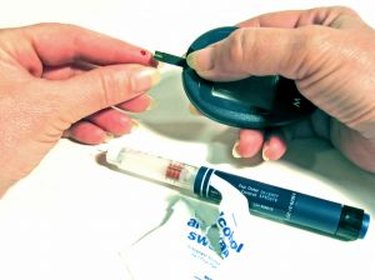
Glucose is a type of sugar that is found in the bloodstream. Blood glucose is the main energy source of the body. Having a healthy blood glucose or blood sugar level is important to optimal health and survival. As glucose in the blood begins to rise, typically after a meal, the pancreas releases insulin to help the cells of the body use the glucose for fuel and energy. If someone has diabetes, and his pancreas secretes little to no insulin into the bloodstream, the blood sugar levels begin to rise. If not treated properly with an insulin injection, the levels can quickly rise over 500mg. Any blood glucose level over 500mg is considered a medical emergency.
Diabetes
Video of the Day
Most people who have had a blood glucose level over 500mg are considered to have diabetes. According to the American Diabetes Association, over 23.6 million people have diabetes. Diabetes is a serious disease that causes unstable blood sugar levels. There are three main types of diabetes; Type 1, Type 2 and gestational diabetes. Type I generally occurs when a patient is young and is sometimes referred to as juvenile diabetes. Type 2 is a condition in which the body does not produce enough insulin to bring blood sugars down, the patient becomes dependent on insulin injections. Gestational diabetes occurs when a woman becomes pregnant. If blood sugar levels are not brought down or treated, it can lead to serious conditions and birth defects that can harm both mother and child.
Video of the Day
Causes
When a blood glucose level gets over 500mg, one of the first things a doctor will do is determine what is causing the high blood sugar level. Generally, the cause is uncontrolled diabetes. As someone continues to eat foods that may be high in sugar or high in carbohydrate, his blood sugar levels begin to rise over normal levels. If his body does not secrete insulin to bring the levels down or to maintain them between 85mg and 100mg, the glucose will continue to rise. Even if the body is producing a minimal amount of insulin, it may not be enough to bring levels back down to a healthy range, even when the person is not eating. Glucose levels may rise in people with diabetes, if they are sick or have another underlying illness.
Symptoms
Two of the symptoms of high blood sugar are extreme thirst and frequent urination. Tiredness, dizziness, blurred vision, confusion and rapid breathing can also be symptoms. If these symptoms suddenly appear in someone who has diabetes, a blood glucose meter is the easiest way to determine if the blood sugar is running high.
Effects
The effects of having a consistent blood glucose level over 500mg can be devastating on the body. When diabetes is not properly treated with diet, exercise, oral medication or insulin, diabetes can begin to affect areas of the body. Diabetes can cause complications such as heart disease and stroke, blindness, hypertension, diabetic neuropathy, nerve damage, depression, complications with feet, kidney disease and limb amputation.
Treatment
The first method of treatment for a blood glucose level over 500mg is to be placed in an emergency room or hospital for effective treatment. The medical staff may give the patient an intravenous line of rapid-acting insulin. There are different types of insulin, such as rapid, short, intermediate, long-acting and a premixed variety. The key is to bring the levels down as quickly as possible and keep them down. The staff will check blood sugar levels with a monitor and blood work until they are regulated and under control.
Is this an emergency? If you are experiencing serious medical symptoms, please see the National Library of Medicine’s list of signs you need emergency medical attention or call 911.